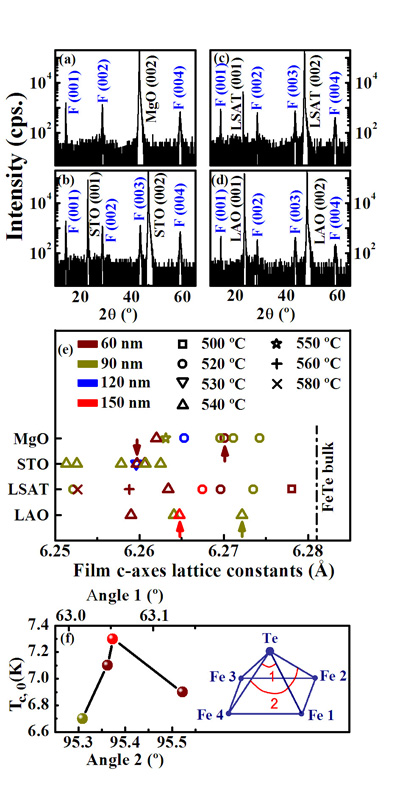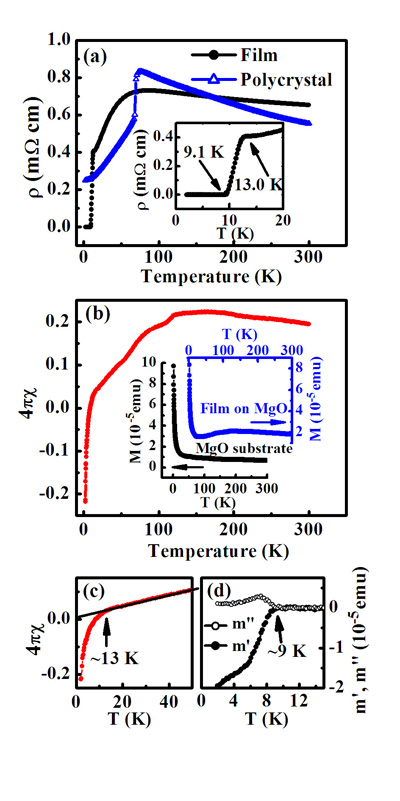Non-superconducting parent compound material turns superconducting when a thin film
As an important area of condensed matter physics, thin film studies have helped push forward the semiconductor and optics industries and stimulated the emergence and growth of several research areas in which dimensions and sizes dominate, such as quantum confinement and surface and interface effects. For superconductivity in particular, thin films have served as important media for the exploration and synthesis of new materials because of their metastability. For example, Nb3Ge films of the A15 structure held the record of the highest superconducting transition temperature for a long period of time before the discovery of cuprate HTS superconductors in the mid 1980’s. In recent years, interfacial superconductivity in thin films, and interface effects in integrated films composed of superconducting and ferromagnetic or ferroelectric thin films have become major frontiers of thin film research in condensed matter physics. Meanwhile, their study is also important in the applications of superconducting materials, including microwave applications, electronics, electric power transmission, and quantum computing.
Research on thin films has progressed slowly since the discovery of iron based superconductors in 2008, because it is hard to control precisely the stoichiometry of the desired metastable phase, and also the competition among different thermodynamic phases can lead to the presence of minor amounts of impurity phases, which is acceptable sometimes in the case of bulk materials but is not allowed for low dimensional thin film materials. In the four superconducting iron based crystal structures found so far, a common feature is the superconducting Fe-X (X = As, P, Se, S, or Te) layer, in which the iron chalcogenide is a binary alloy with the simplest structure compared with its pnictides counterparts. Superconducting, epitaxial, and single-phase iron based superconductor thin films have been realized only in chalcogenides, while for pnictides, no superconducting or impurity free thin films have been obtained yet after almost two years of effort.
Recently, Lixin Cao from the National Laboratory of Superconductivity of the Institute of Physics, Chinese Academy of Sciences, and his students Ye Han and Weiyong Li, in collaboration with other researchers, successfully synthesized epitaxial single-phase superconducting FeSe thin films. They reported their achievements at the 10th National Symposium on Superconducting Thin Films and Devices (Dalian, China, October 11-15, 2008), and in the J. of Phys. C 21, 235702, (2009), and have also applied for a patent.
In the following year, they conducted a systematic study on thin films of the iron chalcogenides, FeSe, Fe(Se,Te), and FeTe. They found that the FeTe parent compound becomes superconducting when in the form of a thin film at a transition temperature of 13 K, which is about the same as the highest value that can be realized in Fe(Se,Te) solid solution, and is higher than that of FeSe. This result was published in Phys. Rev. Lett. 104 017003 (2010) on Jan 8 this year.
This result is interesting since bulk FeTe does not superconduct under ambient or high pressures. Superconductivity in the iron based superconductors is believed to be related to spin density waves. Enhanced spin fluctuations in FeSe have been observed under pressure accompanied by an increase in the transition temperature up to 37 K, while it was predicted theoretically that since FeTe has stronger spin fluctuations than FeSe it should therefore have an even higher transition temperature. However, such speculations were not supported by experiments. Lixin Cao and his colleagues realized that superconductivity can be introduced into stretched but not compressed thin film lattices, analogous to a “negative” static pressure effect. Meanwhile, they realized that the first order structural and magnetic phase transitions found at about 70 K in non-superconducting FeTe bulk specimens are dramatically softened in the superconducting thin films.
This work paves the way for exploring new iron based superconductor materials and for studying the mechanism of superconductivity. This work is supported by the Chinese Academy of Sciences, National Science Foundation of China, and the Ministry of Science and Technology of China.
 |
Figure 1 (a) X ray diffraction spectra of superconducting FeTe films deposited on four different kinds of substrates, (b) c-axis lattice constants of 32 thin films, and (c) Fe-Te-Fe bond angles. It can be seen that the films have a shorter c-axis but a longer a-axis, and enlarged Fe-Te-Fe bond angles. |
| |
|
 |
Figure 2 Resistivity and magnetization vs temperature measurements for an FeTe thin film. The softening of the first order magnetic transition can be clearly seen. |
| |
|



